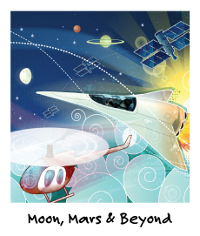Activity: Solving Real Challenges with Engineering
 (This is an eGFI original class activity inspired by a teaching idea from Kevin J. Anderson, who also provided useful guidance. The activity is also available in .pdf form.)
(This is an eGFI original class activity inspired by a teaching idea from Kevin J. Anderson, who also provided useful guidance. The activity is also available in .pdf form.)
Level: Grades 5-9, Time Needed: Two class periods, varying
Engineer Your World with eGFI
In our first eGFI Teachers’ contest, we asked for innovative ways to use our new engineering discipline cards in the classroom. Readers responded with great ideas. Though we had a hard time choosing just one, former teacher Kevin Anderson’s submission stood out from the rest. His idea, to have students come up with different, real-world challenges and then decide which engineering disciplines would tackle them, could be an excellent way to introduce engineering in the classroom.
We’ve expanded on Anderson’s idea, making it into a comprehensive, three-part class activity. In the first phase, students form groups and are given a pack of the cards and a free, printable worksheet that we’ve provided. The handout, to be done together cooperatively by the group members, is designed to introduce the different engineering disciplines, along with what things each type of engineer does, and help students familiarize themselves with the cards.
The next day, after going through the worksheet answers, the class must come up with a list of real-world challenges, either local or global in scale. Students must then decide which engineering disciplines they think would be involved in solving the challenges.
In the final part of the activity, students independently choose one of the engineering disciplines as their favorite and write a short essay about a way that an engineer could tackle one of the challenges. A student could describe a possible new and fun invention or imagine that he or she is that engineer and tell a story about it. In essence, students get to be a type of engineer of their choosing and have some fun while thinking critically about an important issue.
Part 1: Meet the Disciplines & Worksheet
Before making a list of local or world problems, it is important that students become familiar with the engineering disciplines. So, this part of the activity has students learning hands-on with the cards and doing a group handout on them. We have provided two sets of worksheets: one for middle and early high school, and an easier one for elementary school. Depending on the level being taught, choose one that you feel is most appropriate.
Materials
- Packs of eGFI Cards (1 per group) – Available in the eGFI Shop
- The Group Worksheet – Elementary School (.pdf)
- The Group Worksheet Answers – Elementary School (.pdf)
- The Group Worksheet – Middle School (.pdf)
- The Group Worksheet Answers – Middle School (.pdf)
Procedure
Give an introduction to engineering and go through the cards in front of the class. Then, have students form groups of 3 or 4 or assign them to groups. Give a pack of the eGFI classroom cards to each group and have the students look them over and pass them around the group. Allot five minutes or so for this before passing out the group worksheet. Have students work together within their group to find the answers through the information on the cards. After the groups have filled out all the answers, go over them in class and ask if there are any questions. Collect the cards for redistribution in the next class period.
Part 2: List Challenges & Assign Engineers
Have students return to the same groups they had before and redistribute the eGFI cards. Ask the students to think of challenges/difficulties facing the world or their local community and brainstorm in the groups. Ask them to think of what engineering disciplines from the cards might go with each challenge. You may have to provide an example. Some examples include cybersecurity, energy solutions, air pollution, access to clean drinking water, food shortages, longer-lasting bridges or roads, better medical equipment, etc. As the students respond with ideas of challenges, list them on a chalkboard or whiteboard. If they still have trouble, provide some more examples.
Go through the challenges one at a time and ask the class to come up with one or more engineering disciplines from the cards that would theoretically address each problem. Have each student who responds tell why she or he thinks a particular engineering discipline would be appropriate. Make sure students know that there can be more than one right answer. An example of a discipline may need to be given in the beginning or in conjunction with some of the problems. Explain why your example would work. For instance: agricultural engineers would be needed to help with food supply because they grow and ship food. Environmental engineers and mechanical engineers would be needed to develop an electric car. Biomedical, materials, and chemical engineers would all be needed to develop better and lighter prosthetic limbs (and then manufacturing and industrial engineers would be needed to produce them).
Consider adding in other kinds of engineers to fill in the “holes” for certain challenges, and ask students if they understand why. For example, if no student has come up with it, list a materials engineer for the challenge of creating better public transportation, and then ask the class how a materials engineer would be involved. One possible answer: materials engineers would be needed to develop safer, lighter, and stronger materials for trains and buses.
 Children in Africa pour fresh, clean water into jugs.
Children in Africa pour fresh, clean water into jugs.
Variations
1.) Try making the answers into a game for points. Assign numbers, colors, or some other differentiating label to the groups. After writing the challenges for the class to see, list the labels of the different groups so that points can be added. The answering student holds up the discipline’s card and explains the answer. For every right answer (and there can be many for some problems), that student’s group gets a point. (Consider giving credit for answers that are a little bit of a stretch, but are well-explained). The group with the most points at the end of the exercise gets extra credit or some sort of prize.
Encouraging Dialogue: If another student does not think a student’s answer would work, and if time allows, encourage open but civil discussion about it (consider giving points to both students for developing their arguments).
Once the class has gone through all of the problems, tally up the points and take down the names of the winning group(s) for extra credit (or give out the prize).
2.) Try this activity hyper-locally and bring in copies of local newspapers or clippings/print-outs of articles so that students can better come up with problems to address.
3.) Consider connecting with local engineers to learn more as an educator or invite one or more to come in to speak to the class about what they do. This could be a highly valuable element of an engineering lesson, and likely a memorable one.
4.) Need examples of specific world problems that are already being addressed? Try the National Academy of Engineering’s Grand Challenges for Engineering.
Part 3: Be an Engineer
After the world-issues list exercise, have students individually pick a favorite engineering discipline and write an essay about how, if they were that type of engineer, they would help solve one of the challenges. Since engineering challenges are interdisciplinary in nature, have students in higher levels include other engineering and science professionals, perhaps three. One way to accomplish this is to have students think up a new and unique invention and creatively describe how it would tackle the challenge. Another way is to have them describe the “story” of how they, as the engineer, would go about tackling the issue with other professionals. Provide examples from some of the best responses from the listing activity. Allow students, if they wish, to tackle a problem that hasn’t been listed.
The essay writing can be done either in class or for homework. Have students include information they learned in class and from the cards. If they create an invention, have them include a drawing. The length of the essay and whether or not it is graded can be altered depending on time restraints, grade and learning level, and if the writing is done in class.
If pressed for time, this part of the activity can be optional.
Extensions
Consider keeping the eGFI Cards in a communal class library for use on other projects. If given as part of homework, direct students to the eGFI online digital cards to help with the student essays: http://www.egfi-k12.org/ (industrial engineering is not included in the online version).
Filed under: Class Activities, Grades 6-8, Grades 9-12, Grades K-5
Tags: Civil Engineering, Class Activities, Engineering, Environmental Engineering, Grand Challenges








